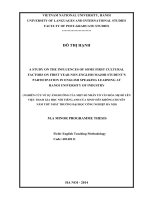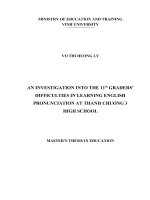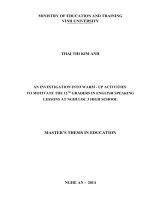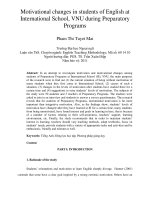Spin Effects in Forward π0-Production in Polarized Proton-Proton Collisions at STAR
Bạn đang xem bản rút gọn của tài liệu. Xem và tải ngay bản đầy đủ của tài liệu tại đây (1.28 MB, 19 trang )
Spin Effects in Forward π0-Production
in Polarized
Proton-Proton Collisions at STAR
Dmitry Morozov, IHEP (Protvino)
for the STAR Collaboration
Outlook
Motivation
STAR/FPD overview
Single Spin Asymmetry at FPD
0
Differential cross sections for forward π -Production
Separated xF and pT dependence of cross section
Conclusions
Motivation
p +p→π0+Х
Sivers effect:
T
Flavor dependent correlation between the proton spin (Sp), momentum (Pp) and transverse momentum (k ) of the unpolarized partons inside. The
T
unpolarized parton distribution function fq(x,k ) is modified to:
⊥
S
⋅
(
P
×
k
1
P
p
q)
⊥
⊥
N
⊥
Collins
ƒ qeffect:
(x,k q ,S P ) = ƒ q(x,kq ) + Δq ƒ q(x,kq )
⊥
2
T
S
P
k
Correlation between the quark spin (sq), momentum (pq) and transverse momentum (k ) of the pion. The
P fragmentation
P
qfunction of transversely
polarized quark q takes the form:
s q ⋅ (p q × k π⊥ )
1
N
⊥
ˆ π/q (z,kπ ) + ∆ Dπ/q (z,kπ )
Dπ/q (z,k ,s q ) = D
2
p q × k π⊥
⊥
π
⊥
∆qNfq – Sivers and ∆NDπ/q- Collins Functions may produce
azimuthal anisotropy
The STAR Collaboration
522 collaborators
51 institutions
12 countries
Solenoid Tracker At RHIC
STAR detector layout
TPC: -1.0 < η < 1.0
FTPC: 2.8 < | η| < 3.8
BBC : 2.2 < | η| < 5.0
EEMC:1 < η < 2
BEMC:0 < η < 1
FPD: |η| ~ 4.0 & ~3.7
Forward Pion Detector
FPD module (7×7 matrix of PbGlass: 3.8 × 3.8 × 45 cm3)
7 Pb-Glass active preshower
detectors
Two 48-strip scintillator SMD
Pb plate in front ~2.5 radiation
lengths
Single Spin Asymmetry
Definition:
AN =
1
PBeam
⋅
dσ − dσ
dσ ↑ + dσ ↓
↑
PBeam – beam polarization
↑(↓)
0
dσ
– differential cross section of π then
incoming proton has spin up(down)
Two measurements:
Single arm calorimeter:
N ↑ − RN ↓
AN =
⋅ ↑
↓
R – relativePluminosity
(by BBC)
Beam N + RN
1
L↑
R= ↓
L
Two arms (left-right) calorimeter:
N↑ ⋅N↓ − N↑ ⋅ N↓
1
L
R
R
L
No relative luminosity
AN =
⋅ needed
PBeam N ↑ ⋅ N ↓ + N ↑ ⋅ N ↓
L
R
R
L
Left
π0,
xF<0
↓
π 0,
xF>0
0
p positive AN: more π going
p
left to polarized beam
Right
First AN Measurement at STAR
STAR collaboration
Phys. Rev. Lett. 92 (2004)
171801
Similar to result from E704 experiment
(√s=20 GeV, 0.5 < pT < 2.0 GeV/c)
Can be described by several models:
Sivers: spin and k⊥ correlation in
parton distribution functions (initial
state)
Collins: spin and k⊥ correlation in
fragmentation function (final state)
Qiu and Sterman (initial state) /
Koike (final state): twist-3 pQCD
calculations, multi-parton correlations
√s=200 GeV, <η> = 3.8
AN for Forward π0 at STAR
Shown at SPIN 2004, Trieste, Italy
The asymmetry is found to be zero
for negative -0.6 < xF < -0.2
AN for positive xF is consistent with
zero up to xF ~ 0.35, then increases
with increasing xF
Run2 (2002): <PBeam>(online) = 20%,
integrated luminosity ~ 0.15 pb-1
Run3 (2003): <PBeam>(online) = 30%,
integrated luminosity ~ 0.5 pb-1
→ more precise measurements
pp→π 0X cross sections at 200 GeV
The error bars are point-to-point
systematic and statistical errors added in
quadrature
The inclusive differential cross section
for π0 production is consistent with NLO
pQCD calculations at 3.3 < η < 4.0
As η increases, systematics regarding
the comparison with NLO pQCD
calculations begin to emerge. The data
at low pT are more consistent with the
Kretzer set of fragmentation functions.
Similar to what was observed by
PHENIX.
Separated xF and pT dependence
The data is represented in the way
similar to J. Singh, et al Nucl. Phys. B140
(1978) 189 - ISR experiment at √s=45
GeV
Cross sections fall with pT at fixed xF
with exponent (~ 6) independent of xF
Data show exponential dependence on
xF with fixed pT = 2 GeV/c. The value of
the fitted exponent (~5) may be
sensitive to the interplay between hard
and soft scattering processes
Although
Data accumulated in different running years
with different calorimeters
with different readout electronics
taken at different angles
Conclusions
0
Large spin effects have been found at forward π production in p p reaction at highest energy √s = 200 GeV
The single spin asymmetry for positive xF is consistent with zero up to xF~0.35, then increases with increasing xF
The asymmetry is found to be zero for negative xF
The inclusive differential cross section for forward π
was observed at lower √s
0
production at √s = 200 GeV is consistent with NLO pQCD calculations, in contrast to what
Mapping of the cross section in xF pT plane has begun … coming soon with analyzing power!
BACK-UP SLIDES
Systematics
Measurements utilizing
independent calorimeters
consistent within uncertainties
Systematics:
Normalization uncertainty = 16%:
position uncertainty (dominant)
Energy dependent uncertainty = 13% - 27%:
energy calibration to 1% (dominant)
background/bin migration correction
kinematical constraints
MC & Data comparison
Di-Photon Mass Reconstruction
Pb-Glass calorimeter analysis includes:
Clustering analysis
Fit to measured and parameterized shower shape
Applying cuts:
Number of photons ≥ 2
Etot > 20 GeV
Fiducial volume cut = 1/2 cell from the calorimeter edge
Energy sharing
zγ γ =
E1 − E2
(E + E )
0
Gains are determined from π peak position for each
1 tower2
< 0.7
(<0.3 for cross sections)
Energy dependent gain correction
Run/Luminosity dependent gain correction
MC to data comparison
Mass resolution ~ 20 MeV
The calibration is known at 2% level
Efficiencies is geometrically determined (dominated by the
geometrical acceptance of the calorimeter)
Cluster categorization
2 photon cluster example
Energy
Try both
1γ Cluster
2γ Cluster
2nd moment of cluster (long axis)
Time/luminosity dependent
gain shift corrections
Luminosity
vs PMT gain
Gain stability (before correction)
Gain stability (after correction)









